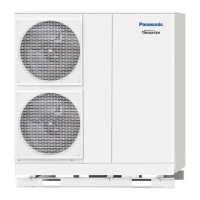113
Aquarea air-to-water heat pumps - Planning and installation manual - 02/2022
Planning
5
Consideration of the nominal ow rate
For ecient heat generation, heat pumps use a temperature dierence of about 5 K between the
supply and return water ow. This distinguishes them from heat sources with boilers, which can
work without any problem with a temperature dierence of about 10 or 20 K between the supply
and return water ow. A consequence of the small temperature dierence in heat pumps is that the
ow rate of heat pumps, which is needed to transport the heat within the circuit, must be higher
than for heat sources with boilers with the same thermal output. The nominal ow rate and the
resulting resistance of the pipe network must therefore be given special attention at the time of
design.
Consideration of the nominal pipe width
The pressure drop in the pipe rises exponentially with the ow rate. This means that doubling the
ow rate causes the pressure drop to increase by a factor of 4. The decisive aspect for this is the
ow speed in the pipe that depends on the ow rate and inner diameter.
As an alternative to a pipe network calculation, a nomogram can be used to determine the pressure
drop across pipe segments. Recommendations for designing the main distribution circuit are:
● The ow speed should be in the range of 0.3 to max. 1.5 m/s.
● The pressure drop per metre should be about 0.1 kPa/m.
Based on these criteria, the required nominal pipe width can be read o from the copper tube
nomogram. To determine the pipe network resistance of a complete pipe run, rst, the pressure
drop per metre must be multiplied by the length of each pipe segment, and then the pressure drops
of all segments must be summed up. The total resistance of a complete pipe run is obtained as the
total pressure drop of all pipe segments multiplied by a lump sum supplement factor of 1.5.
!
IMPORTANT
The total of the individual resistances of all components of the pipe network must not exceed the
pump discharge head for the nominal ow rate. If the pipe network resistance is too high, the unit’s
integrated water circulation pump cannot achieve the nominal ow rate. The heat pump control
functions will register a shortfall of the minimum circulation quantity and throw an alarm.
5.3.3 Hydraulic balancing
Hydraulic balancing of the heat transfer system is the process of optimising the set ow rates for
several pipe segments through regulating valves. This prevents individual building areas from being
excessively overheated, while other areas with a lower ow rate remain cold. Hydraulic balancing
therefore raises the living comfort and is, at the same time, also a requirement for ecient
operation of the air-to-water heat pump. Therefore, hydraulic balancing is also a prerequisite for the
nancial promotion of heat pumps.
5.3.4 Special points related to cooling
Hydraulically, a heat pump system with cooling mode does not dier from a heating-only system.
However, to correctly determine the total annual amount of heat and cold delivered by the heat
pump, which is needed to calculate the seasonal coecient of performance, it is necessary to use
energy meters which record the amount of heat as well as the amount of cold.
5.3.5 Expansion vessel
The Aquarea heat pumps have an integral expansion vessel with a model-specic volume of 6 or
10 litres (see table) and an initial pressure of 1 bar.
The volume of the expansion vessel is adequate for heating systems whose total water quantity
and its static height (dierence of the highest point of the system to the expansion vessel) must not
exceed dened limits.

